Donald Trump Media Coverage Has Created a New Crisis of Credibility
Almost 50 years after former Vice President Spiro Agnew launched a conservative campaign against the press, our journalistic institutions are being challenged for being too hard on Hillary Clinton and too timid toward the right in the 2016 election.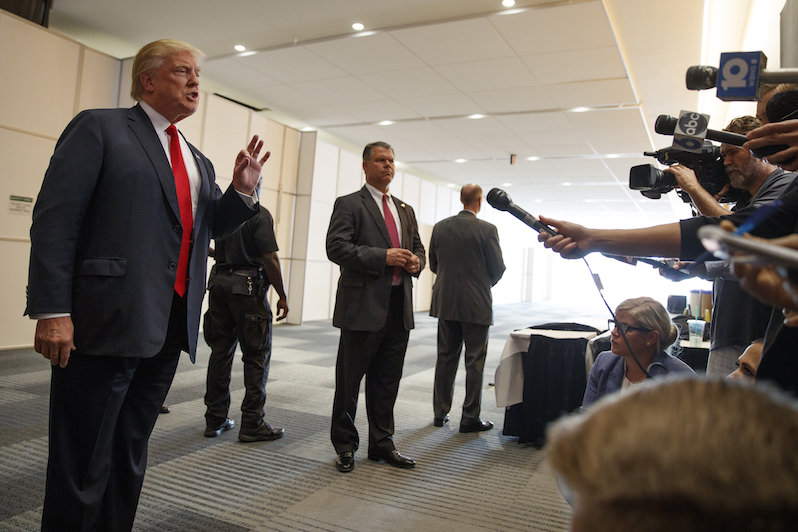
Donald Trump speaks to reporters in Columbus, Ohio. (Evan Vucci / AP)
Spiro Agnew is remembered for pleading no contest to tax evasion charges related to bribery and resigning as Richard Nixon’s vice president. But his signal political achievement was igniting a campaign that endured for more than four decades painting the mainstream media as biased, liberal and elitist.
Anti-media sentiment had long been bubbling on the right when Agnew targeted what were then the Big Three television networks for representing “a concentration of power over American public opinion unknown in history.”
“The American people would rightly not tolerate this kind of concentration of power in government,” Agnew declared in a 1969 speech in Des Moines. “Is it not fair and relevant to question its concentration in the hands of a tiny and closed fraternity of privileged men, elected by no one, and enjoying a monopoly sanctioned and licensed by government?”
Agnew was unrelenting. With help from William Safire and Pat Buchanan, gifted Nixon speechwriters (and, later, columnists), he coined many memorable phrases, including the alliterative “nattering nabobs of negativism.”
Rarely has a concerted political effort been more successful. Ever since, reporters, editors and producers have incessantly looked over their right shoulders, fearing they’d be assailed as secret carriers of the liberal virus.
But the 2016 campaign has brought an intense progressive counterattack on media timidity toward the right. Coverage of Donald Trump has become the occasion for a new crisis of credibility.
There is the matter of Trump’s outsized access to television time during the primaries that dwarfed the attention given to his competitors. Liberals insist further that Trump is being held to a much lower standard than is Hillary Clinton, which, in turn, means that while relatively short shrift is given to each new Trump scandal, the same old Clinton scandals get covered again and again.
Allowing Trump to dominate television time during the primary campaign has nothing directly to do with the liberal-conservative argument, but it’s something the media will have to answer for. This disadvantaged other Republican presidential candidates and reflected a hunger for ratings that overcame any concern for balance.
But the coverage of Trump and Clinton does suggest that a media exquisitely sensitive to conservative criticism now overcompensates against the other side. Josh Marshall, the founder of the Talking Points Memo blog, offered one of the clearest statements of the problem. “There’s little doubt,” he wrote last week, “that the scrutiny of the Clinton Foundation and Clinton’s emails has had a repetitive, hyper-skeptical and saturation coverage that hasn’t been close to matched by any investigative story about Donald Trump. It’s not remotely close.”
The issue is not asking the media to shy away from holding Clinton accountable. But journalists need to ask whether they have created a narrative about Clinton that paints her as less trustworthy than Trump even though the factual evidence is overwhelming that he lies far more than she does.
New York Times columnist Nicholas Kristof pointed to PolitiFact’s finding that while 53 percent of the Trump statements it checked were “False” or “Pants on Fire” howlers, only 13 percent of Clinton’s were. “There’s no comparison with Trump,” Kristof wrote.
Ideological concerns aside, Marshall argued that “Trump’s repeated false statements were so brazen and repetitive” as to put all of the media’s traditional rules and practices “under strain.” Trump keeps saying that he opposed the Iraq War when the evidence from 2002 and 2003 shows he supported it. And the birther in chief who made his name on the right by insinuating for years that Barack Obama was ineligible to be president had the effrontery to say, falsely, that Clinton had started the whole thing.
Journalists have been reluctant to call Trump a liar, even when he lies. But the manipulative nature of his birther announcement unleashed what Washington Post media columnist Margaret Sullivan called “some long overdue indignation” among reporters. There was evidence, in the headlines and the news stories, that the remaining resistance to using the word “lie” with reference to Trump was ebbing.
Liberals’ complaints about the media are themselves typically dismissed as partisan, and sure, the liberals are furious. They’re furious that the right’s own partisan media campaign has intimidated journalistic institutions. They’re furious that Clinton’s shortcomings are magnified and harped on while negative stories about Trump often get report-once-and-move-on treatment. And they’re furious when Trump’s lies aren’t called lies.
But critics’ motives shouldn’t matter. What counts is whether their complaints are justified. For the first time since Agnew kicked off the great conservative campaign against the media, those who run our journalistic institutions are being systematically challenged as to whether they are so worried about condemnation from the right that they’re now demonstrably biased against the Democratic candidate for president.
Thus has media criticism — finally — become fair and balanced.
With an uncertain future and a new administration casting doubt on press freedoms, the danger is clear: The truth is at risk.
Now is the time to give. Your tax-deductible support allows us to dig deeper, delivering fearless investigative reporting and analysis that exposes what’s really happening — without compromise.
Stand with our courageous journalists. Donate today to protect a free press, uphold democracy and unearth untold stories.
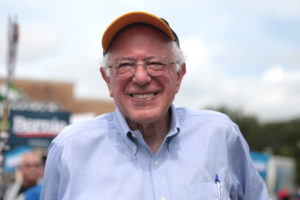

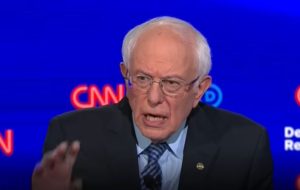

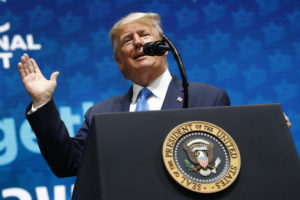
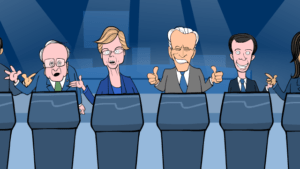
You need to be a supporter to comment.
There are currently no responses to this article.
Be the first to respond.